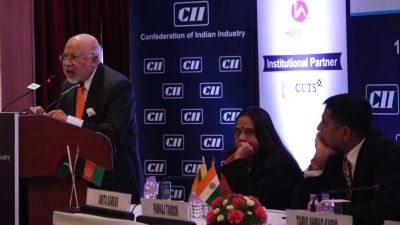Kathuria explained that the people of both nations, especially those in their poor and isolated border regions, will benefit enormously if barriers to cross-border trade are reduced and ultimately dismantled.
“If trade is made easier, Bangladeshi enterprises can grasp new opportunities to ramp up their exports to India. They can benefit from India’s vast markets as well as its investments and technology, while Bangladeshi workers can gain from more and better jobs,” said Kathuria. “This will help Bangladesh increase its growth rate from 6 to 8% per annum and bring it closer to fulfilling its aspiration of attaining middle-income status by 2021.”
India stands to benefit too. Bangladesh, with some 150 million people, presents a large and growing market for India’s entrepreneurs. Indian companies can gain from Bangladesh’s competitive labor and lower costs of production to form a common value chain that is beneficial to all. And, in helping Bangladesh’s economy grow, economic activity in India’s own northeastern states can get a much-needed boost, since they are geographically closer to this eastern neighbor.
India has already provided duty-free access for all Bangladeshi products, with the exception of 25 tobacco and liquor goods. Bangladesh, however, still retains 225 items on its sensitive list. The study shows that a bilateral free trade agreement between the two countries would lift Bangladesh’s exports to India by 182%. This figure would rise dramatically to nearly 300% if physical connectivity was also improved. “This is, however, only a small part of the picture,” explained Kathuria. “The potential for growth is enormous.”
Addressing the blocks
So, what are the stumbling blocks? “Firstly, there are only two border crossings of international standards along the extensive land border between the two countries through which goods can move,” explained Kathuria. “Trucks on both sides have to unload their goods at the border before they are transferred to trucks belonging to the other country. This is unnecessarily expensive and time-consuming,” he said, adding that the World Bank Group’s private sector lending arm – the International Finance Corporation – is working to bring several more such “land ports” up to international standards.
Moreover, non-tariff barriers in both countries – such as inefficient customs procedures that still do not transfer documents electronically, India’s excessive requirements for sanitary and phytosanitary compliance, delays in testing of goods, and difficulties in obtaining long-term business visas – add hugely to the challenges faced by traders and entrepreneurs on both sides.
Big dreams, big gains
“We have to think big if we want to achieve large gains,” said Tariq Ahmad Karim, Bangladesh’s high commissioner to India. “We have much more to offer – electronics, refrigerators, bicycles, with all their components made in Bangladesh.”
Ranjan Mathai, India’s foreign secretary, reiterated that India’s prosperity is linked with that of its neighbors. There is a long to-do list, he said; this includes improving air services and telecommunications links for which industry and government will need to work together.
Clearly, once the people on both sides see the benefits of cooperation with their neighbors, the process of economic integration will be truly irreversible. And the countries of South Asia can possibly regain their old role as key players in the arena of global trade.

